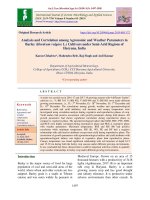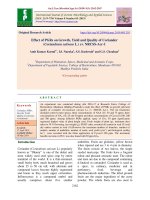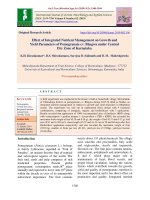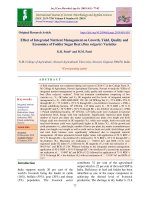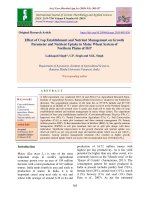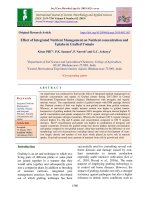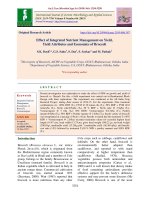Effect of integrated nutrient management on growth parameters of coriander (Coriandrum sativum L.) cultivars under telangana conditions
Bạn đang xem bản rút gọn của tài liệu. Xem và tải ngay bản đầy đủ của tài liệu tại đây (329.46 KB, 7 trang )
Int.J.Curr.Microbiol.App.Sci (2018) 7(11): 2871-2877
International Journal of Current Microbiology and Applied Sciences
ISSN: 2319-7706 Volume 7 Number 11 (2018)
Journal homepage:
Original Research Article
/>
Effect of Integrated Nutrient Management on Growth Parameters of
Coriander (Coriandrum sativum L.) Cultivars under Telangana Conditions
P. Suman*, D. Lakshminarayana, P. Prasanth and D. Saida Naik
Department of Plantation, Spices, Medicinal and Aromatic crops, College of Horticulture, Sri
Konda Laxman Telangana State Horticultural University, Rajendranagar-500 030,
Hyderabad, India
*Corresponding author
ABSTRACT
Keywords
Azospirillum, PSB, FYM,
Vermicompost, RDF,
AD-1 and Suguna
Article Info
Accepted:
22 October 2018
Available Online:
10 November 2018
A field experiment was conducted during rabi 2017-18 at PG block, College of
Horticulture, Sri Konda Laxman Telangana State Horticultural University, Hyderabad,
Telangana, India, to study the effect of integrated nutrient management on growth
parameters of coriander (Coriandrum sativum L.) cultivars. The experiment was evaluated
in randomized block design with factorial concept consists two factors like Cultivars and
Inorganic, Organic and Bio fertilizers. The first factor comprised of two cultivars i.e. AD-1
and Suguna besides the second factor consists fertilizer levels of F 1 - 100% RDF (15-40-20
NPK Kg ha-1), F2 - 75% RDF + Farmyard Manure (FYM @10 t ha -1) + Azospirillum and
PSB (5g Kg-1 of seed as seed inoculation + 5 Kg ha-1 as soil application). F3 - 75% RDF +
Vermicompost (VC @ 5t ha-1) + Azospirillum and PSB (5g Kg-1 of seed as seed
inoculation + 5 Kg ha-1 as soil application), F4 - 50% RDF + Farmyard Manure (FYM
@10 t ha-1) + Azospirillum and PSB (5g Kg-1 of seed as seed inoculation + 5 Kg ha-1 as
soil application), F5 - 50% RDF + Vermicompost (VC @ 5t ha-1) + Azospirillum and PSB
(5g Kg-1 of seed as seed inoculation + 5 Kg ha-1 as soil application). Ten treatment
combinations were replicated thrice. Among the treatments, F3-75% RDF + Vermicompost
@ 5t ha-1 + Azospirillum and PSB (5g Kg-1 of seed as seed inoculation + 5 Kg ha-1 as soil
application) with the variety V2-Suguna recorded least number of days taken to 50 per cent
and 100 per cent seed germination and maximum plant height, number of secondary
branches per plant, leaf area, minimum number of days taken to first and 50 per cent
flowering, number of umbels per plant and umbellate per umbel.
Introduction
Coriander (Coriandrum sativum L.) is an
annual herbaceous plant locally known as
Dhania belongs to the family Apiaceae and is
native to the Mediterranean region. The name
was derived from the Greek word ‘koris’ and
was given on accounts of its unpleasant odour
of unripe green fruits. Coriander is extensively
grown in Bangladesh, India, Russia, Central
Europe and Morocco and it has been
cultivated since human antiquity (Bhuiyan et
al., 2009). India is the biggest producer,
consumer and exporter of coriander in the
world and is mainly grown in Rajasthan,
Gujarat, Andhra Pradesh, Madhya Pradesh,
2871
Int.J.Curr.Microbiol.App.Sci (2018) 7(11): 2871-2877
Tamil Nadu,
Telangana.
Orissa,
Karnataka
and
In India coriander is cultivated in an area of
6.74 lakh ha with a production of 8.83 lakh
MT, where as in Telangana, the area and
production are 10,000 ha and 400 MT
respectively (National Horticulture Board,
2016).
In recent years, bio fertilizers have emerged as
an important component of integrated nutrient
supply system and have shown promise to
improve crop yields and nutrient supplies.
Azotobacter, PSB and Azospirillum are the
most wide spread bio fertilizers significantly
contributing N, P and K to plants and also
providing resistance to drought situation
(Maheshwari et al., 1991).
The application of nutrients through various
sources is newer approach and being
advocated for sustainable production. The
integrated nutrient management has a crucial
role in improving the plant physiology
characters that builds levels of resistance and
reduces the incidence of disease and pest
attacks (Mirchandani and Mirchandani, 2005).
Nitrogen fixing bacteria like Azospirillum
have a great potential to reduce the
nitrogenous fertilizer requirements whereas,
Phosphorus solubilising bacteria is known to
make the soil fixed phosphorus in to readily
available form, subsequently increased the
productivity of the crops.
Materials and Methods
Present field experiment was conducted
during rabi 2017-18 at PG block, College of
Horticulture, Sri Konda Laxman Telangana
State Horticultural University, Hyderabad,
Telangana, India.
The experiment was carried out with two
varieties i.e. AD-1 and Suguna with five
fertilizer levels i.e. 100% RDF (15-40-20 NPK
Kg ha-1), 75% RDF + Farmyard Manure
(FYM @10 t ha-1) + Azospirillum and PSB (5g
Kg-1 of seed as seed inoculation + 5 Kg ha-1 as
soil application), 75% RDF + Vermicompost
(VC @ 5t ha-1) + Azospirillum and PSB (5g
Kg-1 of seed as seed inoculation + 5 Kg ha-1 as
soil application), 50% RDF + Farmyard
Manure (FYM @10 t ha-1) + Azospirillum and
PSB (5g Kg-1 of seed as seed inoculation + 5
Kg ha-1 as soil application), 50% RDF +
Vermicompost (VC @ 5t ha-1) + Azospirillum
and PSB (5g Kg-1 of seed as seed inoculation
+ 5 Kg ha-1 as soil application) in a Factorial
Randomized Block Design and replicated
thrice. Seeds were sown in the plot of 2 m ×
1.5 m at spacing of 30 cm × 10 cm.
The recommended dosages of N, P and K @
15:40:20 kg ha-1 were applied in the form of
urea, single super phosphate and muriate of
potash respectively. Urea was applied in the
three splits, the first as basal application and
the other two doses at 25 and 50 days after
sowing. The entire dose of single super
phosphate and muriate of potash were applied
at the time of sowing as basal dose. The
vermicompost and the farmyard Manure were
incorporated in to respective plots just prior to
sowing of seed and then slightly covered with
the fine soil.
Slurry of 200 g of each of Azospirillum and
Phosphorous Solubilising Bacteria were
dissolved in 1000 ml of jaggery solution (100
g of jaggery in 1000 ml of water) separately
and combination of both 100 g Azospirillum
and 100 g Phosphorous Solubilising Bacteria
were dissolved in 1000 ml of jaggery solution.
The coriander seeds were dipped in the slurry
for about 30 minutes before sowing. Need
based cultural and plant protection operations
were taken up to the seed harvest. Five plant
samples from each replication were selected at
random to record data on growth characters.
The experimental data was analysed
2872
Int.J.Curr.Microbiol.App.Sci (2018) 7(11): 2871-2877
statistically by the method of analysis of
variance as out lined by Panse and Sukhatme
(1985).
Results and Discussion
Growth parameters
Growth parameters such as plant height,
number of secondary branches per plant and
leaf area showed a significant difference
between fertilizer levels and varieties at 60, 90
days and at harvest stage.
Among the treatments, F3-75% RDF +
Vermicompost @ 5t ha-1 + Azospirillum and
PSB (5g Kg-1 of seed as seed inoculation + 5
Kg ha-1 as soil application) with the variety
V2-Suguna recorded higher plant height (97.67
cm) (Table 1), number of secondary branches
per plant (18.30) (Table 2) and maximum leaf
area (79.73 cm2) (Table 3) at harvest stage.
It was due to the seed treatment with
Azospirillum and Phosphorous solubilising
bacteria enhanced the nitrogen and other
nutrients availability, resulted in increased
vegetative growth (Mounika et al., 2018).
Similar results were also reported by Sahu et
al., (2014), Tripathi et al., (2013) and Hnamte
et al., (2013) in coriander who stated that
synergistic effect of inorganic and organic
fertilizer increased plant height.
with other reports of Sahu et al., (2014) in
coriander, who stated that more number of
secondary branches per plant was due to
treatment supplied with bio-fertilizers and
organic manures.
Maximum leaf area was due to the balanced
fertilizer application increased leaf area which
might be due to the availability of all nutrients
in the rhizosphere (Priyadarshini et al., 2017).
Similar results reported by Nagar et al., (2009)
in coriander, who reported that available
nutrients favoured better growth and
development of the crop.
Flowering parameters
Flowering parameters such as number of days
taken to first and 50 per cent flowering,
number of umbels per plant and umbellate per
umbel showed a significant difference
between fertilizer levels and varieties. Among
the treatments, F3-75% RDF + Vermicompost
@ 5t ha-1 + Azospirillum and PSB (5g Kg-1 of
seed as seed inoculation + 5 Kg ha-1 as soil
application) with the variety V2-Suguna
recorded minimum number of days taken to
first flowering (39.00 days) and 50 per cent
flowering (47.30 days) (Table 4). Similarly the
same treatment recorded maximum number of
umbels per plant (37.50) and umbellate per
umbel (8.53) (Table 5).
Integrated application of bio fertilizers with
inorganic fertilizers have increased plant
height by enhancing the nitrogen content and
the rate of photosynthesis which is in
agreement with (Migahed et al., 2004;
Choudhary et al., 2004).
Least number of days taken to first flowering
and 50 per cent flowering might be due that
bio fertilizer treated plants became
physiologically more active and enable to
synthesize required amounts of hormones. The
results are comparable with that of Hnamte et
al., (2013).
More number of secondary branches per plant
was due to higher plant height, subsequently
more photosynthates, led to production of
more number of secondary branches per plant.
The present investigation was in consistent
Maximum number of umbels per plant might
be due to luxuriant vegetative growth, more
number of branches per plant, broader leaf
area and least number of days taken to 50 per
cent flowering.
2873
Int.J.Curr.Microbiol.App.Sci (2018) 7(11): 2871-2877
Table.1 Effect of integrated nutrient management on plant height (cm) in coriander cultivars at different growth stages
Fertilizers /
Treatments(F)
F1
F2
F3
F4
F5
Mean
Fertilizers(F)
Varieties(V)
(V × F)
Plant Height (cm)
V1
8.40
11.77
12.70
10.43
10.90
10.84
SEm ±
0.49
0.31
0.69
30 DAS
V2
9.80
13.07
13.17
11.10
11.63
11.75
CD at 5%
1.46
NS
NS
Mean
9.10d
12.42ab
12.93a
10.77c
11.27bc
V1
39.40
49.00
52.00
42.00
44.00
45.28b
SEm ±
0.51
0.32
0.72
60 DAS
V2
40.33
54.33
56.50
46.40
48.70
49.25a
CD at 5%
1.51
0.95
2.13
Mean
39.87e
51.67b
54.25a
44.20d
46.35c
V1
69.50
85.33
88.17
73.33
76.00
78.47b
SEm ±
0.75
0.47
1.05
90 DAS
V2
70.20
91.33
94.67
79.60
82.83
83.73a
CD at 5%
2.21
1.40
3.13
Mean
69.85e
88.33b
91.42a
76.47d
79.42c
At Harvest stage
V1
V2
72.50
73.13
88.33
94.33
91.17
97.67
76.33
82.60
79.00
85.83
81.47b
86.71sa
SEm ±
CD at 5%
0.75
2.23
0.47
1.41
1.06
3.15
Mean
72.82e
91.33b
94.42a
79.47d
82.42c
Table.2 Effect of integrated nutrient management on number of secondary branches per plant in coriander cultivars at
Different growth stages
Fertilizers /
Treatments(F)
F1
F2
F3
F4
F5
Mean
Fertilizers(F)
Varieties(V)
(V × F)
Number of secondary branches per plant
V1
4.37
5.00
5.13
4.53
4.67
4.74
SEm ±
0.08
0.05
0.11
30 DAS
V2
4.40
5.20
5.30
4.70
4.80
4.88
CD at 5%
0.23
NS
NS
Mean
4.38d
5.10ab
5.22a
4.62c
4.73bc
V1
8.00
10.40
11.20
8.80
9.10
9.50b
SEm ±
0.33
0.21
0.47
60 DAS
V2
8.50
12.30
14.30
9.40
9.70
10.84a
CD at 5%
0.98
0.62
1.39
Mean
8.25d
11.35b
12.75 a
9.10cd
9.40c
2874
V1
10.10
12.40
13.20
10.80
11.10
11.52b
SEm ±
0.28
0.18
0.40
90 DAS
V2
10.50
14.30
16.30
11.40
11.70
12.84a
CD at 5%
0.84
0.53
1.19
Mean
10.30d
13.35b
14.75a
11.10cd
11.40c
At Harvest stage
V1
V2
Mean
12.00
12.50
12.25e
14.40
16.30
15.35b
15.20
18.30
16.75a
12.80
13.40
13.10cd
13.10
13.70
13.40c
13.50b
14.84a
SEm ± CD at 5%
0.26
0.76
0.16
0.48
0.36
1.08
Int.J.Curr.Microbiol.App.Sci (2018) 7(11): 2871-2877
Table.3 Effect of integrated nutrient management on leaf area (cm2) in coriander cultivars at different growth stages
Fertilizers /
Treatments(F)
F1
F2
F3
F4
F5
Mean
Fertilizers(F)
Varieties(V)
(V × F)
Leaf Area (cm2)
30 DAS
60 DAS
V1
V2
Mean
V1
V2
e
26.37
27.37
26.87
61.40
62.40
ab
31.39
32.40
31.90
67.50
70.80
32.13
33.33
32.73a 68.80
73.70
cd
28.80
30.05
29.43
63.30
65.40
c
29.74
30.40
30.07
64.50
66.90
b
29.69
30.71
65.10
67.84a
SEm ± CD at 5%
SEm ± CD at 5%
0.55
1.63
0.42
1.25
0.35
NS
0.27
0.79
0.77
NS
0.60
1.77
Mean
61.90e
69.15b
71.25a
64.35d
65.70c
90 DAS
At Harvest stage
V1
V2
Mean
V1
V2
Mean
e
64.50
65.40
64.95
65.50
66.80
66.15e
b
70.54
74.91
72.73
71.25
76.91
74.08b
72.57
77.73
75.15a 73.60
79.73
76.67a
66.90
68.53
67.72cd 67.40
69.60
68.50cd
c
67.50
69.43
68.47
68.50
70.10
69.30c
68.40b
71.20a
69.25b
72.63a
SEm ± CD at 5%
SEm ± CD at 5%
0.43
1.27
0.58
1.72
0.27
0.80
0.37
1.09
0.60
1.79
0.82
2.43
Table.4 Effect of integrated nutrient management on days taken to first and 50 per cent flowering in coriander cultivars
Fertilizers /
Treatments(F)
F1
F2
F3
F4
F5
Mean
Fertilizers(F)
Varieties(V)
(V × F)
Days taken to first flowering
V1
50.00
44.27
43.00
48.30
47.30
46.57b
SEm ±
0.41
0.26
0.58
V2
49.80
42.00
39.00
46.97
45.90
44.73a
CD at 5%
1.22
0.77
1.73
Mean
49.90e
43.13b
41.00a
47.63cd
46.60c
2875
Days taken to 50 per cent flowering
V1
58.20
52.60
52.00
56.30
55.30
54.88b
SEm ±
0.40
0.25
0.56
V2
57.30
50.57
47.30
54.10
53.47
52.55a
CD at 5%
1.18
0.75
1.67
Mean
57.75e
51.58b
49.65 a
55.20cd
54.38c
Int.J.Curr.Microbiol.App.Sci (2018) 7(11): 2871-2877
Table.5 Effect of integrated nutrient management on number of umbels per plant and umbellate per umbel in coriander cultivars
Fertilizers /
Treatments(F)
Number of umbels per plant
V1
V2
Mean
Number of umbellate per umbel
V1
V2
Mean
F1
25.80
26.30
26.05e
6.85
7.06
6.96e
F2
31.60
34.40
33.00b
7.74
8.28
8.01b
F3
32.20
37.50
34.85a
7.97
8.53
8.25a
F4
27.30
29.20
28.25cd
7.22
7.41
7.32d
F5
28.40
30.50
29.45c
7.39
7.54
7.47c
Mean
29.06b
31.58a
7.43b
7.76a
SEm ±
CD at 5%
SEm ±
CD at 5%
Fertilizers(F)
0.47
1.38
0.04
0.12
Varieties(V)
0.29
0.87
0.03
0.08
(V × F)
0.66
1.95
0.06
0.17
2876
Int.J.Curr.Microbiol.App.Sci (2018) 7(11): 2871-2877
The highest number of umbellate per umbel was
due to more number of umbels per plant as
compared to rest of the fertilizer level
treatments. Similar results were also reported by
Tripathi et al., (2013), Mounika et al., (2018) in
coriander.
References
Bhuiyan, M.N.I, Begum, J., Sultana, M. 2009.
Chemical composition of leaf and seed
essential oil of Coriandrum sativum L.
from Bangladesh. Bangladesh Journal of
Pharmacology. 4:150-153.
Choudhary, G.R., and Jat, N.L. 2004. Response
of coriander (Coriandrum sativum) to
inorganic
nitrogen,
farm
yard
biofertilizer. Indian Journal Agriculture
Sciences78: 761-763.
Hnamte, V., Chatterjee, R. and Tania, C. 2013.
Growth, Flowering, Fruit Setting and
Maturity Behaviour of Coriander
(Coriandrum sativum L.) with organics
including biofertilizers and inorganics.
The Bioscan. 8(3): 791-793.
Maheshwari, S.K., Gangreede, S.K. and Trived,
K.C. 1991. Comparative responses of
palmarosa to Azotobacter and nitrogen
under rainfed and irrigated swards. Indian
Perf. 35(2): 108-111.
Migahed, H.A., Ahmed, A.E. and Abdel Ghany,
B.F. 2004. Effect of different bacterial
strains as biofertilizer agents on growth,
production and oil of Apiumgraveolens
under calcareous soil. Arab Universities
Journal of Agriculture Sciences. 12(2):
511-525.
Mirchandani, T.B. and Mirchandani, R. 2005.
For balanced specialty nutrition in N.
Ram (ed.) The Hindu Survey of the
Indian agriculture, Chennai 202- 205.
Mounika, Y., Thanuja Sivaram, G., Syam
Sundar Reddy, P. and Ramaiah, M. 2018.
Influence
of
Biofertilizers
and
Micronutrients on Growth, Seed Yield
and Quality of Coriander (Coriandrum
sativum L.) Cv. Sadhana. International
Journal of Current Microbiology and
Applied Sciences. 7(01): 2099-2107.
Nagar, R.K., Meena, B.S. and Dadheech, R.C.
2009. Effect of Weed and Nutrient
Management on Growth, Yield and
Quality of Coriander (Coriandrum
sativum L.). Indian Journal Weed
Science. 41(4): 183-188.
National Horticulture board. 2016. National
Horticulture Database. Ministry of
Agriculture, Govt. of India, Guargon,
India.
(www.nhb.gov.in/area-pro/
horst_galance.)
Panse, V.G. and Sukhtme, P.V.1985. Stastical
methods for agricultural workers. Indian
council of Agricultural Research New
Delhi. 87-89.
Priyadarshini, J., Panda, C.M. and Sethi, D.
2017. Effect of Integrated nutrient
management Practices on Yield, Yield
Attributes and Economics of Coriander
(Coriandrum sativum L.). International
Journal of Current Microbiology and
Applied Sciences. 6(5): 1306-1312.
Sahu, R.L., Sahu, H. and Kumar, S. 2014.
Effect of application of inorganic
fertilizers and biofertilizers on growth
components and yield traits of coriander
(Coriandrum sativum L.). International
Journal of Agricultural Sciences. 10(1):
433-436.
Tripathi, M.L., Singh, H. and Chouhan, S.V.S.
2013.
Response
of
Coriander
(Coriandrum sativum L.) to Integrated
Nutrient Management. Technofame- A
Journal of Multidisciplinary Advance
Research. 2(2): 43- 46.
How to cite this article:
Suman, P., D. Lakshminarayana, P. Prasanth and Saida Naik, D. 2018. Effect of Integrated Nutrient
Management on Growth Parameters of Coriander (Coriandrum sativum L.) Cultivars under
Telangana Conditions. Int.J.Curr.Microbiol.App.Sci. 7(11): 2871-2877.
doi: />
2877

